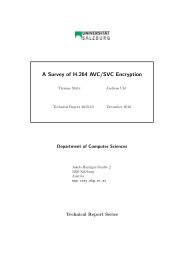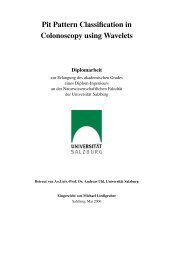Single-sensor hand and footprint-based multimodal biometric ...
Single-sensor hand and footprint-based multimodal biometric ...
Single-sensor hand and footprint-based multimodal biometric ...
You also want an ePaper? Increase the reach of your titles
YUMPU automatically turns print PDFs into web optimized ePapers that Google loves.
FNMR =<br />
�η<br />
−∞<br />
2.3 System performance<br />
P (s|H0) ds. (2.4)<br />
The selection of an arbitrary operating point, i.e. tuple (FMR, FNMR)η of FMR <strong>and</strong><br />
FNMR values for some fixed threshold η, is typically insufficient for comparison. Instead,<br />
different algorithms are compared using the set of all possible operating points depicted<br />
in the form of a Receiver Operating Characteristics (ROC) curve [1] (see Figure 2.2).<br />
Alternatively, for performance comparison the following indicators are frequently adopted<br />
(see also the Fingerprint Verification Competition 2006 [50]):<br />
• Equal Error Rate (EER): the value such that FMR = FNMR;<br />
• Zero False Match Rate (ZeroFMR): the lowest FNMR for FMR = 0%;<br />
• Zero False Non-Match Rate (ZeroFNMR): the lowest FMR for FNMR = 0%;<br />
• Minimum Half Total Error Rate (MinHTER): the global minimum value of the<br />
following function [30]:<br />
HTER(t) :=<br />
FMR(t) + FNMR(t)<br />
. (2.5)<br />
2<br />
As can be seen in Figure 2.2, each of these performance indicators refers to a single point in<br />
the ROC curve: PEER is the intersection of the ROC curve with the first median <strong>and</strong> corresponds<br />
to the EER indicator. Analogously PZeroFNMR <strong>and</strong> PZeroFMR refer to ZeroFNMR<br />
<strong>and</strong> ZeroFMR <strong>and</strong> can be identified as intersections of the ROC curve with the y-axis (<strong>and</strong><br />
x-axis respectively) with closest distance to the origin. Finally, PMinHTER corresponds to<br />
the operating point where the half of the sum of coordinates is a minimum.<br />
It should be pointed out that, for identification systems, the situation is slightly different.<br />
Here, using the notions above, the hypotheses could be reformulated as follows:<br />
H0 : ∃M ∈ M : X ≡ M, i.e. there exists an enroled template with the same identity;<br />
(2.6)<br />
Ha : ∀M ∈ M : X �≡ M, i.e. within M no template with the same identity exists. (2.7)<br />
Within this context, a False Accept occurs, if X is found to be matched with a template<br />
of an enroled member mi ∈ M, while in reality it is an imposter <strong>and</strong> False Rejects<br />
denote falsely rejected genuine authentication attempts. Matching with multiple (correct<br />
or incorrect) c<strong>and</strong>idates is ignored in this case.<br />
13








